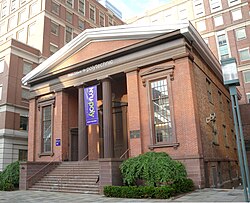Wunsch Building
| Wunsch Building; the former Bridge Street Methodist Church, the former First Free Congregational Church | |
|---|---|
 Wunsch Building | |
 | |
| General information | |
| Architectural style | Greek Revival |
| Town or city | Brooklyn, New York |
| Country | United States of America |
| Construction started | 1844 |
| Completed | 1847 |
| Client | Methodist Episcopal Church of the United States |
| Technical details | |
| Structural system | Masonry |
The Wunsch Building of New York University Tandon School of Engineering is the present name of the former Bridge Street Methodist Church, a former Methodist church located at 311 Bridge Street, on the east side between Johnson Street and Myrtle Avenue, in Brooklyn, New York City. The Greek Revival temple was erected 1844. It is also recorded as the First Congregational Church.
The building dates back to 1847 and was the first independent black church in Brooklyn. It was also a stop on the Underground Railroad and has been designated a historic landmark since November 24, 1981.[1]
The former church was recorded in the AIA Guide to NYC (1977) as the NYU Tandon School of Engineering annex. “A Greek Revival temple in brick with wood columns and entablature: chaste, excepting the later Victorian stained glass, which is exuberant even from the outside.”[2][3]
The church building is now called the Wunsch Building and houses the school's Undergraduate Admissions offices. It is used to host many social, cultural, and academic events for the school and community.[4]
References
- ^ http://www.brooklyneagle.com/categories/gallery.php?id=32084&nr_fotki=1
- ^ Norval White and Elliot Willensky, AIA Guide to New York City, rev. ed., (New York: Collier Books, 1978), p.368.
- ^ J. Russiello, A Sympathetic Planning Hierarchy for Redundant Churches: A Comparison of Continued Use and Reuse in Denmark, England and the United States of America (MSc Conservation of Historic Buildings, University of Bath, 2008), p.381, 352.
- ^ http://www.nyu.edu/public.affairs/releases/detail/2294
- Churches completed in 1847
- 19th-century Methodist church buildings in the United States
- Methodist churches in New York
- Congregational churches in New York
- Churches in Brooklyn
- Closed churches in New York City
- Churches on the Underground Railroad
- Former churches in New York
- Greek Revival architecture in New York City
- Greek Revival churches in New York
- 1847 establishments in New York
- New York University
